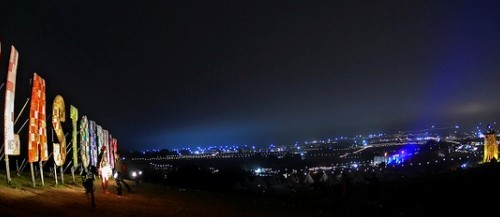Glastonbury 2013 became the most digitally covered festival in history at the end of last month, with 1.7 million social mentions over the course of the five days, and #Glastonbury trending in the UK and worldwide for much of the weekend. Social interaction peaked on Saturday June 29th, with nine out of 10 UK Twitter trends related to the festival.
It is clear that while the Arctic Monkeys, the Rolling Stones and Mumford and Sons headlined the Pyramid Stage, social media firmly established itself as the second screen to the festival. Even Mick Jagger, one of the most talked about artists at the festival, used social media to take fans behind the scenes of his Glastonbury experience in a series of Instagram photos posted throughout the weekend.
These extraordinary levels of social interaction, along with 120 live performances and over 250 hours of live coverage from Glastonbury streamed by the BBC, transformed the festival into a shared experience for millions of music fans across the globe. Glastonbury is not an isolated example of this convergence though, and the online and offline world is increasingly integrating to deliver quality live music experiences to fans.
In the digital age, there truly are no limitations to the reach of live music.
Recent studies show that the rise of mobile internet usage, along with advancements in social media, offer fans the opportunity to increasingly challenge and reshape the boundaries of live concerts. These combined factors have had a significant, positive impact on both live performances and the relationships between musicians and their fans. Not only can music fans now find and connect with each other at shows, they can also tweet and text concert set-lists and other information as it happens, thereby allowing non-attendees around the world to feel part of the event.
Although music fans can’t yet download the concert experience, the social atmosphere of the concert is constantly getting closer to home. Fans that are not physically present at the show can now be incorporated into the real-time “live” experience. Online fans are also gathering as digital communities to enjoy and discuss shows as they happen from the comfort of their sofas. Finally, the real-time nature of tweets and online comments allows fans to give live feedback to performers, and vice versa.
For artists, the digitalisation of live music offers two overarching opportunities; increased connectivity with fans, and access to a global audience. Social media provides a clear channel through which fans, artists and venues can interact in in-depth ways. Twitter and Facebook, for example, offer performers the chance to address their fans in a more individual way than traditional media. As well as offering a direct line of communication with fans, increased connectivity is a method through which to share live performances as promotional tools.
In the digital age, there truly are no limitations to the reach of live music. The social nature and consequent wide-reaching abilities of social media enable artists to surpass geographic and cultural boundaries every day, resulting in new markets and experiences. The global reach does however stem from interactions with followers, and without meaningful interactions the buzz dies down, and people stop sharing. A global audience is available to fans, but it is up to the artists to ensure that they act on the opportunity.
It goes without question that music festivals and live shows would not be the universal experience they are today without the benefits of social media, and from the looks of this summer’s festivals, they will only continue to get more social. When Emily Eavis, chief organiser of Glastonbury, wanted to send her thanks to festival goers, it was fitting that at the end of what was dubbed the most digital Glastonbury ever, she chose Twitter to send her message.






